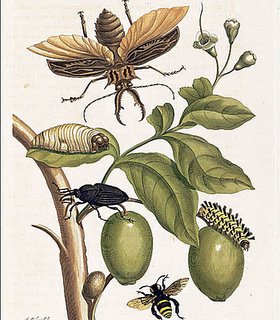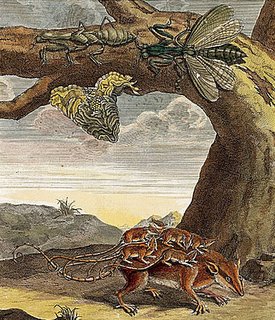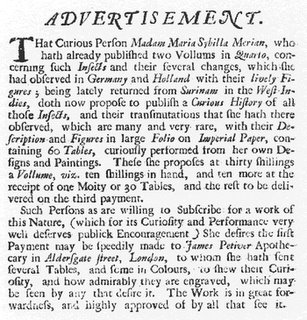

Maria Sibylla Merian (1647-1717) was three years old when her engraver father died. On his deathbed legend states that he predicted that the family name would become famous through his daughter. She developed an interest in the natural world and in insects in particular and she collected specimens for study from a young age. Her mother married a Flemish artist who encouraged Maria with her artistic talents and she began to paint scenes showing the life-cycles of butterflies by preference, in an age when it was widely believed that insects formed naturally from dirt. They moved from Germany to Holland where Maria spent much of the remainder of her life.


Maria found favour with some of the city leaders of Amsterdam after publishing two books of her paintings. She had come there with her daughters from a religious colony after a couple of failed marriages. Through her eldest daughter's marriage to a merchant, she began to be attracted to the South American Dutch colony of Surinam. After eight years planning, she and her youngest daughter went on their own to Surinam, their passage paid for by the city of Amsterdam. She spent two years there continuing with her study and painting of insects.
She released the first volume of her most famous work Metamorphosis Insectorum Surinamensium in 1705 which became the third recording of the pupae-caterpillar-butterfly in print. Her scientific renderings although sometimes inaccurate, are still regarded as a great accomplishment and she attracted the notice and praise of Linneaus. There were a number of publications of this work, with a second volume released after her death. Maria had also painted, engraved and hand coloured a large number of botanical and insect depictions during her latter life teaching of embroidery and painting. So although there were supposedly 60 plates made originally from her time in Surinam, this number burgeoned with reprintings.
Maria died a pauper after having suffered a stroke a few years earlier and another legend has her receiving news of the Russian Tsar's agreement to purchase her papers and paintings on the day she died. In fact, all her works did end up in Russia so it is likely the agreement was reached earlier. They were later returned to Germany.

skip to main |
skip to sidebar


analytics
Books~~Illustrations~~Science~~History~~Visual Materia Obscura~~Eclectic Bookart.

Contact | Who?
Recommended Blogs
Blog Archives
Resource Sites
- digital nz
- library of congress
- british library
- library france
- library holland
- library spain
- library portugal
- european library
- library australia
- collections canada
- digital poland
- nypl digital
- botanicus digital
- v&a collections
- britmuseum prints
- smithsonian search
- smithsonian galaxy
- f.a.m.s.i.
- casglu'r tlysau
- rumsey collection
- manuscript catalogue
- digital scriptorium
- cesg manuscripts
- swiss manuscripts
- pecia mss blog
- digital book index
- rare book room
- online exhibitions
- primary sources
- worldcat search
- library directory
- digital librarian
- intute resources
- warburg institute
- lexilogos links
- digiwiki links
- museum blogs
- book arts web
- culture archive
- conservation articles
- art-history timeline
- visual arts
- arts journal
- artcyclopedia
- ukiyo-e
- calligraphy megapage
- penmanship
- woodblock
- coconino
- alchemy website
- health hist. img-banks
- health history links
- history network
- new advent


















3 comments :
What a magnificent entry and what a stunning selection of images.
However, there's a little detail to correct: The good lady's name was "Merian" not "Meridan" - I know that because she's from a rather influential family from the area around Basel and there are still famous families called "Merian".
Whoops! Thanks Suzanne, that was a typo. It did say 'Merian' in everything I read.
Cheers.
That little Maria Sibylla: your account is rather heart-wrenching, with the father's deathbed prophecy, the fascinating pictures, and her own death as a pauper. It makes a sort of touching allegory of life as an artist...
Post a Comment
Comments are all moderated so don't waste your time spamming: they will never show up.
If you include ANY links that aren't pertinent to the blog post or discussion they will be deleted and a rash will break out in your underwear.
Also: please play the ball and not the person.
Note: only a member of this blog may post a comment.